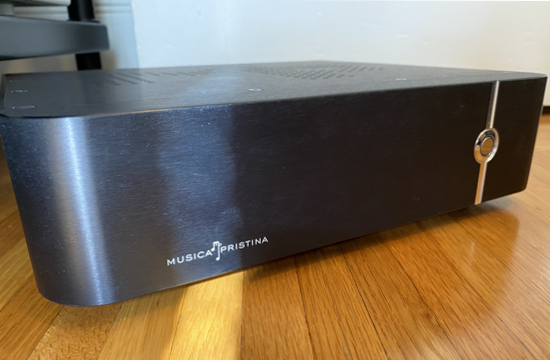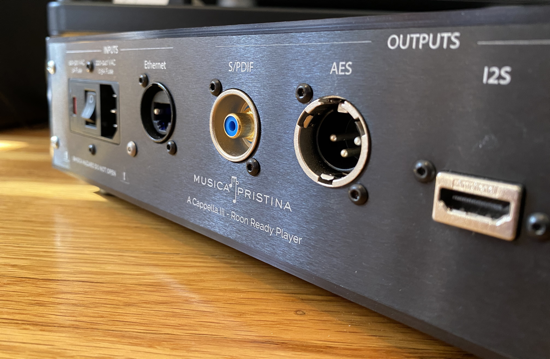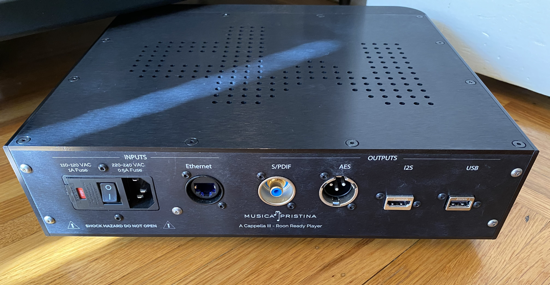
You may be asking, “Why do I need a dedicated streaming transport?” Or, if you already use a computer or an all-in-one streamer, what you may really be asking is, “Does a dedicated streaming transport really make any difference?”
Musica Pristina hopes to answer this question with its A Cappella III streaming transport ($5,120 as reviewed). Using a purpose-built streaming transport is like separating a preamp from an integrated amplifier, or a standalone phono preamp instead of a built-in one. There’s an opportunity for greater attention to detail, an increased budget, and loftier design goals when you split one component into two.
Purchasing a dedicated streaming transport is equivalent to investing in a premium phono preamp for vinyl playback. A higher-quality phono stage will do more justice to your vinyl records. My goal was to determine if the same was true for the way the A Cappella III handled my digital music files and streaming services.
A Cappella III Streaming Transport Design
Musica Pristina’s goal when developing the A Cappella III was to treat your digital music with the utmost care possible. During every step of the engineering and design process, the product’s designers focused on obtaining the lowest possible noise floor. The baseline configuration ($3,995) features a standard USB output. Galvanically isolated USB, AES/coaxial, and I2S outputs are also available as options. The A Cappella III is modular, and it can be upgraded as hardware standards change.

Musica Pristina developed the A Cappella III’s operating system in-house. The system directs traffic through the bespoke hardware which was designed with the shortest signal paths possible. A custom-made linear power supply and precise clock aim to prevent any degradation of the source material. The anodized aluminum enclosure contains no moving parts, produces almost no heat, and is completely silent when in operation.
A Roon Ready Player

Musica Pristina includes a lifetime subscription to the Roon music player software (a $699 value) with the A Cappella III. Installing the Roon Core software on my Windows 10 computer was easy. It immediately recognized the A Cappella III attached to my network. Since the chassis has no LCD screen or transport controls, everything is controlled via the Roon Remote app running on either an iOS or Android device.
It was a good idea to provide a complimentary lifetime subscription for Roon as the exclusive control method for the A Cappella III. This was my first experience using Roon, and it lived up to the hype. Within a few minutes of using the Roon Remote app on my iPad mini, I realized that all of the positive feedback I’d heard about Roon was warranted. It easily beats the competing controller apps I’ve used from Cambridge Audio, Lumin, BluOS, Aurender, and Sonos. Its design is intuitive, it’s incredibly quick and responsive, and it never crashed.
My favorite feature is the global search which autocompletes as you type, based on the content of your local library. When viewing your search results, it’s easy to drill down and select the specific version of the song that you want to hear — either from Tidal, Qobuz, or a local file. It puts all the music at your fingertips, regardless of location or source. When you can’t quite figure out what you want to listen to, the visual way it guides you through your local music library is the best I’ve ever seen.
Performance and Sound Quality

With the A Cappella III in my system, the first thing I noticed is that my “sweet spot” had gotten larger and more stable. I could move my head around several inches without the imaging wavering or shifting. This seamless soundstage meant I didn’t have to be in such an exact spot in order to obtain satisfying performance. Other elements like the rhythmic timing, bass performance, and inner details were all satisfyingly reproduced. Unfortunately, the first review sample developed a problem with intermittent dropouts, but the second unit I received worked perfectly.
Aside from my observation regarding the sweet spot, it’s not about what the A Cappella III does, but what it doesn’t do. After spending over two months listening, I determined the Musica Pristina “house sound” is actually a complete lack of any house sound. There was no obvious EQing, euphoric overtones, or other processing being applied to the music. The A Cappella III doesn’t up-sample or use digital filtering. It successfully demonstrates that less is more, and achieves its goal of not imparting any sonic character of its own.
Review System
When the weakest link is no longer your streaming transport, the performance of the other components in your digital frontend becomes more crucial. During this review, I used a Shunyata Venom 14 power cord ($125) plugged into the A Cappella III, and a Pangea Audio Premier SE digital coaxial cable ($60) to connect to my Marantz SA-KI Ruby DAC. My cable choices are likely on the low-end of what most would be using with a $5,120 streaming transport. You should pay careful attention to the adjacent cables and DAC you use in order to obtain a rewarding system synergy that aligns with your own tastes and preferences.
Conclusion and Value
The decision to exclusively use Roon as the dedicated control method for the A Cappella III means you get arguably the most intuitive and enjoyable way to access your music files and streaming services. Roon is an absolute pleasure to use, and the bar by which all other music playback software should be judged.
Many enthusiasts feel that with high-end audio systems, “everything matters.” While Roon is a bit-perfect playback system, the fact I was running the Roon Core software on a PC will surely set off alarms for purists who don’t want a “noisy” computer in their Hi-Fi system. While Roon itself may or may not impart a sonic fingerprint, I did not find that it took away from the musical engagement I experienced while listening.
If you listen to Tidal, Qobuz, or local files, the A Cappella III has the potential to be a destination piece in your system. While not inexpensive, I like the way it functions as a “set it and forget it” product that will not influence or color the music passing through it. If your ultimate goal is transparency and neutrality, the A Cappella III is a natural choice as the centerpiece of any system you’re building.
Give the Musica Pristina A Cappella III a test run in your own system with the company’s 30-day in-home trial. Once you experience the logical flow of Roon and the way your music sounds without coloration, it might be impossible to go back to your old streamer.

